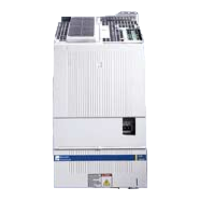4-22 Description of Diagnostic Messages F… and E… ECODRIVE03-SGP-03VRS
DOK-ECODR3-SGP-03VRS**-WA01-EN-P
F812 Motion range exceeded during commutation
A range of +/- 1 pole pair distance is defined, within which the axis may
move during the Automatic Commutation adjustment. If this range is
exceeded, this error message appears.
Cause:
1. The drive enable has been set while the axis was still in motion.
2. The axis has been moved by a mechanical force.
3. Parameters P-0-0560 Commutation adjustment current and P-0-0562
Commutation adjustment periodic time are set too high. Possibly the
mechanical properties of the axis, like friction or weight load, have
changed.
Remedy:
1. Wait until the axis motion stops and set the drive enable once again.
2. Inhibit the influence of the mechanical force.
3. Reduce the parameter values for P-0-0560 Commutation adjustment
current and P-0-0562 Commutation adjustment cycle time. You can
also set them to the default values P-0-0560 Commutation
adjustment current = 25 % and P-0-0562 Commutation adjustment
cycle time = 4 milliseconds.
4. Afterwards, start the command D300 Commutation adjustment to
evaluate once again the optimal parameters.
See also the functional description: "Synchronous Motors"
F822 Encoder 1 failure: signal amplitude wrong
The analog signals of a motor measurement system are used for high
resolution analysis of that measurement system. These are monitored
according to two criteria:
1. The pointer length, which is calculated from the amplified sine
and cosine signals, must be >5 V while the encoder frequency is
<10 kHz. Above that frequency it must be >1 V.
2. The maximum pointer length resulting from the sine and cosine
signals must not exceed 11.8 V.
[]
22
cossin +=lengthpointer V
Fig. 4-4: Pointer length
For checking purposes the encoder signals can be routed to the analog
output of the controller. This is done through the following parameter
setting:
Channel 1:
P-0-0420 = 0; P-0-0421 = 1 (SIN encoder 1); P-0-0422 = 1.0
Channel 2:
P-0-0423 = 0; P-0-0424 = 2 (COS encoder 1); P-0-0422 = 1.0
The input amplifier amplifies the 1Vss encoder signal to the nominal
pointer size of
0.5V * 18.4 = 9.2V
which is then output. So with the appropriate setting of the oscilloscope
(X-Y operation mode) the following signal wave form is produced:

